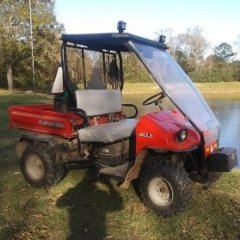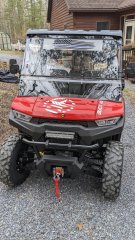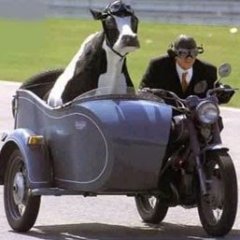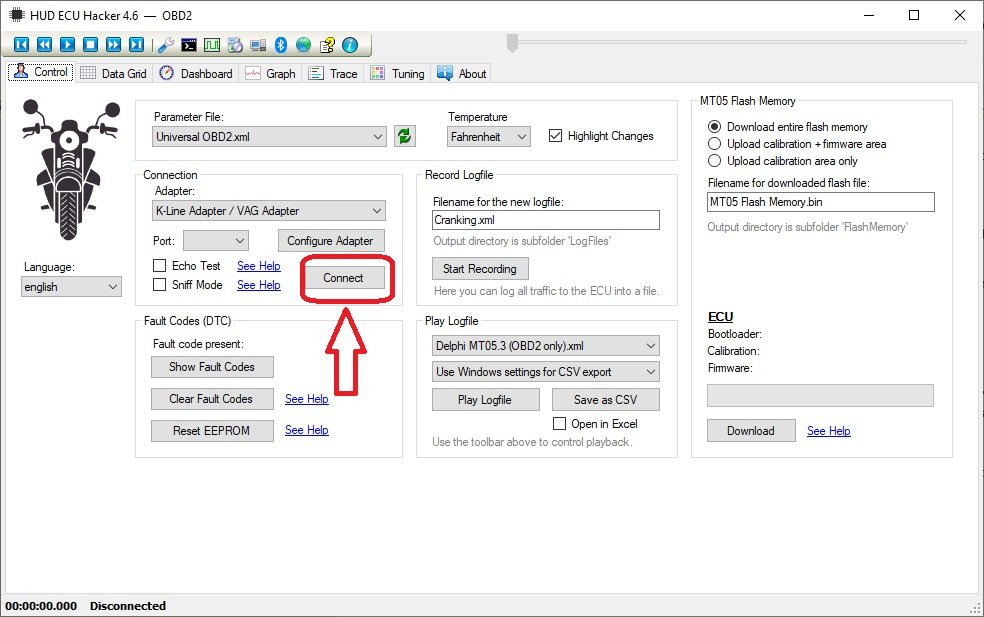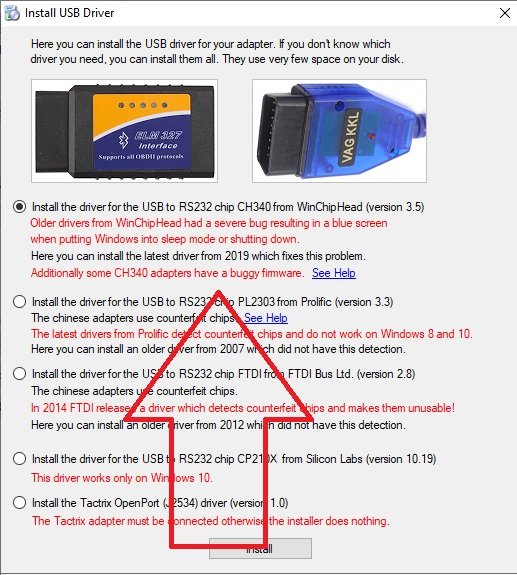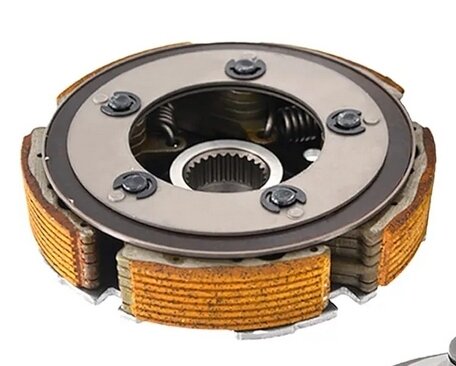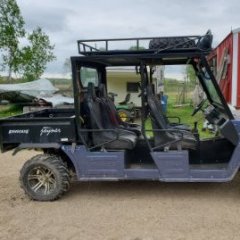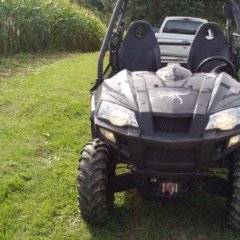Leaderboard
Popular Content
Showing content with the highest reputation since 05/06/2023 in all areas
-
Since I've seen some questions on this I took some pictures and will provide instructions on a valve adjustment for the UT400. This should be the same for the 550's and other various Coleman/Hisun single cylinder models with the cylinder slanted aft. I have seen several people ask of it is really necessary, and read several reports of valves being out of adjustment from the factory. My valves were .004" intake, and .010" exhaust with about 5 hrs on the machine. I've seen different numbers thrown around for factory spec, but I decided to go with 0.005". This is called valve lash. What is is is a gap between the rocker arm and the valve then the camshaft isnt opening the valve. Why does it matter? If it's too large the valve doesn't open all the way, if it's too small the valve dosent close. This can cause valve damage (overheating) as well as loss of engine power (burned fuel is going out exhaust rather than pushing the piston dow). Tools required : 5MM Allen wrench, 10MM box wrench, needle nose pliers, flat feeler gauge set, rags First you need to remove the fan cover on the passenger side. There is a cooling vent hose on the back side, remove the hose clamp and slide it off. From there there are 4x 10mm bolts holding the cover. The forward ones can be accessed from under the seat. Next remove the spark plug from the drivers side. Carefully wiggle the spark plug wire off. Grip it as low as possible and give it a little twisting motion as you pull it off to help free it. Its a tight fit for a socket, but there is a sheet metal wrench in the toolkit that fits it. Unscrew the plug and set it aside. This allows you to spin the motor over freely with no compression to fight. When you reassemble this is a good opportunity to switch to an NGK iridium plug for better performance/less fouling DR8EIX) Next you need to remove the intake and exhaust valve covers. The intake us the forward one. There are 3x 5MM Allen screws to remove. The Exhaust is the rear with 2x 5MM Allen bolts. Both covers have O-Rings instead of gaskets and are reusable. When you remove the rear be careful and use your rags as there will be oil that drips out. Next up we need to spin the motor over to top dead center. Grab each rocker arm and give em a little wiggle up and down. Spin the engine over by grabbing the fan with your other hand. Spin the engine over until both rockers have some wiggle and are loose. Once both rockers are loose slide the feeler gauge in like shown above. Try different feelers as needed to determine your starting spec. You should feel some drag but still be able to move the feeler without too much force. If you need to adjust, use the 10MM wrench to slightly loosen the locknut, then with the correct feeler gauge in place, tighten the top square nut while wiggling the feeler in and out. Once you have it right you need to tighten the 10mm lock nut without moving the square head bolt. Once the lock nut is tight recheck the clearance. That's it, button everything back up and make sure you have it all reassembled before running it again. If you find this helpful give me a thumbs up or comment. If you have any questions or need more help let me know. If there's interest maybe I'll do some more of these4 points
-
Hello to anyone who reads this. I am Jon and I own J&M Outdoor Power, a very small, small engine repair shop. I was approached by Coleman about 6 months ago to become one of their Warranty Centers. I recently received 3 different UT400's and a UT500 all with similar issues. These units range from 2 months to 2 years old. Customers state that the unit(s) was/were running fine, then heard a pop and a loss of power, two would no longer start. The two that would run would not achieve normal operating speed (around 20mph I would say) without redlining the RPMs. I quickly found that the Valve lash on each unit had become too large on some(both intake and exhaust) and too tight on one(just intake). After setting the gaps to .005(I found multiple different people suggesting bigger and smaller gaps, but no definitive Coleman Spec number yet) every unit starts, runs, and achieves top speed without issue. I don't know how many others have come across these issues, and I wanted to get something out on the web for others in the same predicament. Please let me know if you have had similar issues. Edit: I realize that this will not be a fix all solution for this issue, as the oil level and condition should be verified before moving to the valves. Many times improper oil conditions will cause valve lash to change. These units all have good oil and proper oil changes.3 points
-
2 points
-
Are you talking about an electric heater? if yes its likely too much current. There might be 10 amps of available current coming out of the rectifier that isn't already claimed by the ECU and factory lights. 10 amps @ 12V = 120 Watts, which is about what an electric heating pad runs. If you're talking about a fan for a engine coolant based heater it's probably ok. If you have accessories and the running voltage is below 13.5V you have too much stuff attached. If the battery light comes on it means the battery is actively being discharged while running. Stator based charging systems on these things and tractors etc are really meant to power the ECU and factory systems not to provide a lot of extra power for other stuff, it's not like the alternator on a car.2 points
-
2 points
-
The main trick is tilting the front end up. Block the rear wheels and jack up the front end at least a foot. A convenient ditch works well also.....rear wheels in a shallow ditch. The head bleeder screw should be opened. With the engine NOT running, almost fill the radiator (leave some air to avoid a mess) and burp (squeeze the lower hose line before the metal tube at the engine base passenger side floor area). Watch the radiator and the the bleeder. With the radiator "higher" than the head bleeder, the air should be bled and coolant dribble out. Close the bleeder and refill radiator (your clue you displaced the air with coolant) and start the engine. Burp more while running and if you get the circulation going the hoses will warm up. More bubbles should surface at the radiator filler neck. Shut off engine. Open bleeder and release any air in the head. The puke jug needs to be filled about an inch above the full cold line. Use a shop towel as a "seal"and use an air nozzle to SLIGHTLY pressurize the puke tank removing the air from the tubing line to the radiator neck. Then the radiator starts to overflow, a third hand can install the radiator cap. Run the engine and determine the head and hoses are at the close to the same temperature (as in warming up) through out the system. IR temp gun....fairly cheap now....can get real numbers. Scan the radiator, hoses, cylinder and head.....if all close you are done. Recheck fluids when done riding. Recheck the bleeder and top off the puke jug as required.2 points
-
From the look of the picture on the post, I can think of a couple things2 points
-
Its' not a car, this is a motorcycle engine with a small stator charging system. You can't expect to run high wattage accessories like a heater or huge light bars on these things . That will overwhelm the charging system, drain your battery an stop your engine. Could damage the charging system and voltage regulator too. You only have about 10 amps extra to run any accessories including lights.2 points
-
My dealer gave me an electronic version of the service manual and I have sent it to Kingfish. I will see if it will upload here for others to use. I'm not sure if there is a more appropriate way to do this, let me know if there is.. 2015-2017 Service Manual - Sector E1.pdf2 points
-
my Hisun in my Massimo , sold by Tractor Supply, assembled in Dallas, say Made In China on every part of all of it .. Altho it now has multiple Yamaha parts mixed in. lol2 points
-
https://motorcycledoctor.com/wp-content/uploads/2021/08/Valve-Adjustment-HiSun-2.pdf This should do it.2 points
-
Yeah, I adjusted mine multiple times without any luck. I had extended the shifter rod, as mentioned on this board, as well as some videos I watched, and that resolved the shifting issue. Now, after it slips into forward or Reverse, it never slips out. PS: If you go this route, remember to readjust the cable to compensate for the extended shifter. I had to do the adjustment an couple times after extending the shifter and then the problem was resolved.2 points
-
I finally found a service manual in stock and was able to make the adjustments per the specs!2 points
-
Problem was using cheap eBay injector. Bought quality one and hot pipes went away. Running like new.2 points
-
2 points
-
Massimo MSU500 won't shift to low I would check the shift linkage. Adjust it make it a little longer, if it is not long enough it won't shift to low2 points
-
Hello again! I now have a pretty good running Coleman UT400 after a top end rebuild, wet clutch rebuild and a repaired crankcase... ! It plows snow great, but I was also having the jumping out of gear problem, mainly reverse, but a couple times out of forward. I would quickly place it in N and then let the engine idle down and shift again. This worked most of the time. I did some research and found that some have modified the shift linkage. The problem with just adjusting the shift cable is that it really NEEDS more throw, not an adjustment. From what I've read and viewed on the Internet, the linkage arm needs to be about 3/4" longer to gain more throw in both directions. On YouTube, the guy had to remove the shift linkage hole trim and notch the side of the dash to get the shift linkage off the pivot pin. BUT this is NOT necessary. When the "E" clip has been removed and you fish it out of the firewall somewhere, the shift lever is now loose. I had to pop the top of the shift knob off, remove the retaining screw and then heat the lower portion of the knob to get it to come off the lever. Once you have the shift lever loose, push it towards the right to slide it off the pivot shaft. But it won't come off just yet. Use a small pry bar/screw driver and slide the nylon flanged bushing out of the left side of the lever. This lets the lever slide off and get into a "loose" condition and it will twist and come right off without removing the dash trim, that could be a bugger to get back on correctly. Once the lever is off, press out the other bushing so when you're welding on the linkage arm, you don't melt the bushing. I found a piece of scrap metal the same thickness as the lever arm, just over 1/8" thick, close to 3/16". I cut my arm and beveled the edges for better welding. I added a piece just over 5/8" long and kept about a 1/16" gap between the arm and the new piece. Once welded on bother ends, it adds up to just about 3/4" or so. I reinstalled the lever after painting it and did an adjustment on the cable. By the way, it's easier to remove the cable from the bracket on the frame. This gives you more clearance to maneuver in that area with your hands. ALSO, you will need to get a 12" adjustable wrench and slide it over the cable mounting bracket and tweak, to the front, the steel so the cable is pointed upward a bit to now realign with the new longer shift arm lever. There's more than enough metal for the tweak and it will line up perfectly. I now bottom out the shifter on the transmission BEFORE I run out of throw on the shifter... I've tested it just a bit so far and it shifts much better with the longer throw. One of the Coleman authorized repair facilities said that he worked with Coleman to get a new part that's longer by 3/4". He's modified a few and it works perfectly for him. Just doing the cable will just short you on the other end. Here's some pictures of my modified shift lever etc.2 points
-
In order to connect with the ECU we need two cables. The first is a USB ODBII cable. HUD ECU Hacker’s documentation has a lot of different confusing options, but here’s what I went with and managed to get working, the cable is called “VAG KKL” it is a USB to ODB2 cable. It is available from a variety of sources for $10-15. The second thing we need is a “6 pin delphi to ODB2” adapter cable. It is also available for a similar price. In my case I ordered both from ebay, but there are other sources. Once we have our cable in hand we need to find the plug it in on your machine. My personal rig is a Coleman UT400, but the wire location should be similar for all Hisuns. My cable was located under the middle of the seat area. Just inboard of the battery, where the main wire harness split loom runs. The cable is a 6 pin (3x2) with a dust cap. Remove the dust cap and plug in the 6-pin end of the Delphi adapter cable. Note: When I was done, I left the 6-pin adapter connected, and zip tied it so it now runs to in front of the battery for easier access in the future. Next download and install HUD ECU HACKER DOWNLOAD Open HUD ECU Hacker on your PC It should prompt you to choose a driver to install. This particular cable uses the “CH340” driver (First choice on the menu) click to install, once installed hit the X in the corner to go back to the main page Once the driver is installed plug in the USB Cable, and plug the ODB2 end into the 6 pin adapter. The red led on the adapter should light up indicating it has power. Drop down and pick a com port on the main screen, it should show the VAG KKL adapter as a com port. Click connect on the main menu. It will pop up a bunch of fast scrolling text indicating it is connecting. Once connected you can click through the various tabs to see different data sets. The main menu also has the option to show fault codes, clear fault codes, reset the EPROM back to factory. The other function that may be helpful is recording a log file. You can record a log while operating the unit, and come back later and replay it to try to better diagnose what is happening. Within the various pages you will see the reading from each sensor. Sometimes a sensor reading will be off enough to cause running issues, but not enough for the ECU to realize its an issue. For example if the engine thinks it’s really warm, but its actually cold, it may not inject enough fuel to start. There are also more advanced functions, like adjusting fuel mapping, but that is beyond the scope of this tutorial. Full HUD ECU Hacker Documentation (Very technical reading) If you find this helpful give me a comment below or a thumbs up.2 points
-
DO NOT BUY MASSIMO OR ANYTHING HISUN... you have been warned. You will regret it. They are Chinese junk..1 point
-
1 point
-
Yes, please see what you can do. Now, ads are popping up on top of posts and I cannot shut them down, so I can't even read certain posts. I click on the X in the corner and the ad changes with an arrow in the opposite corner. I click on the arrow and the previous as appears.1 point
-
That's correct on the MA oil. Some of the info in that post is wrong. There are two things moving the power from the engine to the drivetrain: first there's a wet centrifugal clutch, from that drives the primary cvt pulley, which has a belt to the secondary. The friction material on the clutch is prone to slipping with use of additives "energy Conserving II" API rated oils, which are used in most car oils. Cars use a dry transmission, most motorcycles use a wet clutch where the clutch plates are bathed in oil. The MA rated oils don't have that additive which causes wet clutch slip issues. See attached picture of the friction disc of the wet clutch. Yellow stuff is the friction material. Once it starts slipping you get rapid wear, and also a lot of crud in your oil. Generally speaking conventional vs synthetic, synthetic oils have more uniform molecules and hence lubricate better and resist more wear and tear before going out of spec. They also typically have better additive packages, because the manufacturer expects them to be used for more mileage. Conv vs synth it makes little difference, and I would lean towards changing oil early on these machines being a large single cylinder ("thumper") they get more wear and tear than a normal car engine, and also I've read a fair number of timing chain stretching issues, which is typically an issue with accelerated wear of the pins holding the chain.1 point
-
1 point
-
I have a 2022 500 Hisun product, I have had them in the past. I change my oil myself and trying to drain through the hole where I remove the plug is a mess. How does everyone keep the belly pan clean during the oil and filter service? Wes Jackson1 point
-
Same problem with mine. Ended up being starter clutch. Did mine in frame. Had to remove a few things but not too bad of job. Pulley puller is ideal. Got clutch on ebay $27. Look for : Starter Clutch component 23706 For Linhai 260 300 400 ATV UTV Scooter BigHorn1 point
-
Sorry about taking so long to respond. I did resolve the issue by replacing the carb again, but I'm not sure exactly what was wrong with the one that was on the engine. It definitely wasn't gummed up, because it behaved that way right after installation. I believe it was a factory assembly, but I seem to recall having to migrate the jets from my factory original carb. I suspect I forgot a part or otherwise messed up when moving them. With the carb that was acting up, I tried to back out the slotted plug from the underside (the bowl area), and it was seized into the aluminum threads. After mangling it with my screwdriver, I ordered another factory carb that came with the jets preinstalled. Before mounting it to the engine, I compared that new replacement to the one that was having issues. They were 100% identical except, when viewed from below, the slotted brass plug on my previous one was recessed about 1/4" higher up in the carburetor than the new one. So either I significantly over-drove it when installing the jets or I missed a part, such as an orifice disc, when assembling. I'll never know for sure, though, because there was no way I'd get that assembly apart without cutting it. The new-new factory carb has worked great for a couple seasons now with only a minor adjustment to the idle mixture.1 point
-
Sometimes water can come from condensation. My tractor has water separator so that may be a factor why I have no issues anywY good luck.1 point
-
not to mention mosquitoes lol ....and poison ivy.1 point
-
https://motorcycledoctor.com/hisun-parts/magneto-400/ Here one at the motorcycledoctor website.1 point
-
Remove the spark plug. Rotate the engine until the piston is at the top of travel by using a copper wire (soft 10 AWG with rounded end down) and watch the travel up and down. When very close to TDC, the piston will stop going up and "stall" for a bit and then start to fall back down. Rotate "between these two positions" and you have TDC. Easier said than done. A dial indicator can also be used if you have the set up. Getting into the fan side is a pain with the cover.....bolt screw nut inserts usually "spin". Easiest is to take off the belt cover exposing the drive clutch pulley. On the rim of the pulley you can make an narrow ink mark (or tape with a ink pen line). Do the rock back and forth to find the "going up" and the "going down" location on the case. Mark the two locations. In the middle is TDC. Also, try to see if you can find the timing marks noted in the service manual and mark both with paint for future use. I had a simple trick (POSTED) to hold the chain in place and keep it from falling off the crank sprocket when installing the cam gear.....string pulled for a 3rd hand. I like to do a double check after timing the cam and then rotate to the OVERLAP (EXHAUST VALVE closing and INTAKE VALVE just opening) at the other TDC than Compression. Always rotate slowly by hand to check for valve interference. If something is wrong, you don't bend any valves. Rotate the decompression flyweights against the spring return to avoid being fooled by the cam's AUTO decompression mini-cam/button hitting the cam follower.1 point
-
1 point
-
I have a 1999 Mule 550 which only had 25 psi on compression test. Leak down test indicated cylinder or rings issue, as I could clearly hear the air leaking when I removed the dip stick. Nothing out of the exhaust, & maybe a little out of the intake. I've removed the head, & there's a lot of carbon build up on the valves. I've ordered new valves, & am engine rebuilt kit, complete with piston & rings. When you pulled your piston, did you remove the engine, or were you able to remove the piston while the engine was in the frame? Thanks! I made the mistake of buying this sight unseen while I was deployed, & didn't think about asking for a compression test prior to paying.1 point
-
1 point
-
Regular car oil doesn't have the stuff needed to keep wet clutch lubed like it needs Just make sure the oil rated "JASO MA" or "MA2". Synthetic or conventional is up to you. I read somewhere that the "MA2" rating is for engine exhaust with a cat and O2 sensor. And I think the synthetic lets the clutch slip more than conventional. If there is a lot of miles on the clutch with conventional oil. Then switched to synthetic. The clutch is more likely to slip.1 point
-
Thank you. That makes a lot of sense, as I now remember I had a garden tractor doing the same thing and after a valve adjustment, it ran like new. It would be strange though in my case, since I only have 11 hours and about 24 miles on the machine. But seeing how these units were produced with a lot of malfunctions, it's no wonder this would happen early on. I will have to check the valve lash and thank you for the update. I found the procedure here, so if anyone else needs instructions, they can follow this link:1 point
-
Clean the sheaves with soap and water. Then lightly scuff the sides with a brillo pad. Watch a few YouTube videos on replacing the cvt belt. Doesn't have to be same model or same machine. You are just wanting a general look at how to clean up the sheaves. Replaced the clutch 2 times on a cfmoto 600 uforce. Once just ofter I purchased the used machine. Then 8 months later after a catastrophic cvt belt failure flipped me and the wife on its side do8ng about 30mph down the highway. The belt came apart in pieces and chunks and wrapped around the sheaves. Locking the transmission/rear wheels. Then we went sliding down the blacktop. I turned the steering wheel to ease off the highway onto a grass area. Then we flipped on the driver side. Just some bruises and a few scratches. Nothing serious. After getting machine back on its wheels was able to put in neutral and push around. Then called brother-in-law to bring a trailer and load. Repaired the machine and sold at wife's request. Then got a Axis 500. Same cvt belt setup. But in her mind it hadn't tried to kill us. Lol Look at a diy tool for the secondary sheave for a cfmoto. There's a lot of guys that a tool for adjusting the clocking to remove the HD spring. I'm not familiar with your setup. But most are similar. There is a lot of force under that spring. Becareful that spring can seriously hurt or kill you. Also when I got the new Axis I put on a 5-point harness simply because the cfmoto flipped us and the lap belt wasn't enough to keep the wife from getting hurt.1 point
-
1 point
-
I think its interesting that this wire has a 30 amp fuse in it but the other one has a 50 amp fuse. Seems like a mismatch but perhaps different purposes.1 point
-
You are correct Grub. Same diameter is what is critical! Width is personal preference. A lot of working UTVs come narrower in the front. Most sport UTVs are coming all same width, typically all 4 would be the more narrower width.1 point
-
while i didn't eliminate the box, i did relocate the intake to the back of the passenger side and added a motorcycle filter for extra measure... seems to be working so far1 point
-
As of today i have 4 units waiting for updated shift lever . Calling again to find out status . Its nothing new, they have always been horrible about contacts, replies , parts order time frame. I just go with thte flow . You get what you pay for . These units look nice , and actually preform pretty well for the cost . When yu have a Chinese company "Hisun " subbing out prduction to a Vietmese company to build a low cost UTV ,kinda get what you get. Other than the shifter issue, wheel bearings not torqued etc they are pretty decent . Looks like they cloned a Yamaha Rhino . If shift levers are not avail I may start producting some myself . Need to figure out cores, shipping etc .1 point
-
I agree with you, Joe. If they made a filter that could remove all the dirt and other contaminants, we would have much greater oil change frequencies.1 point
-
Gotta agree. I can't see how a siphon pump will extract everything. Drain and fill is the best method.1 point
-
COLEMAN UT 400 NO REVERSE WE FOUND THE CURE! In our case adjustment would make the UT 400 go into reverse but you would loose forward in the doing, very frustrating! However when removing the seat and the upper engine cover you can see the shift lever clearly and with the cable adjusted properly to engage forward and the ever so annoying ratchet sound of reverse gears we found if you apply slight pressure to the shift lever on the transmission it would engage! Turns out there is just simply not enough throw on the cable, So back up to the shift lever and noticed there is a stop next to the detent on the lever that if slightly more gap would allow just a bit more throw. So here is the cure, Remove the nut (10MM) on the cable post, remove the C clip from the pivot post, remove the bezel ring at the shift lever by bending straight the tabs and remove the shift lever. I used a 4 1/2 inch angle grinder with a cut off wheel and removed about 1/2 of the stop on the inside edge next to where the detent ball will sit on both the reverse and forward sides of the lever (cuz lets just be certain) After reassembly it was noted that simply holding the shift lever into the gear you want and ever so gently tapping the throttle the transmission selects both forward and reverse every time without fail. You see the cable is only as long as it is and adjusting it will only make it go one direction further, but by removing a bit of metal it allows the whole thing to travel just enough to make the difference. I'm not going to say this is the end all be all but it sure worked for us and maybe with a bit of luck will for you as well.1 point
-
Just out if curiosity how many miles/hours did you put on it? What exactly are they saying the issue is? Frequently commercial use shortens or negates warranties so that doesn't entirely surprise me.1 point
-
Open up your hood go into the fuse box the fuse is blowing I had the same problem you'll have power to the pump but the fuse works in an opposite way like a reverse grounding system!1 point
-
I received 4 CV boots from Casey very quickly, would have no problem shopping with them again!1 point
-
Couldn't have said it better myself. For a guy who hates Hisun he sure spends a lot of time posting in the Hisun forum...1 point
-
Sounds like it is the parking brake warning. Mine is a 2021 400 and if you shift to F or R with the parking brake on it starts the beeping noise. I would check the adjustment for the parking brake and see if the safety switch is out of adjustment.1 point
-
Against the brute it launch faster than my utv but around 65kph i close the gap and pass in front at around 100kph Against the renegade i stay behind but not by so much distances And against the Polaris on 27" tire it was neck and neck whit my utv until we Reach 30kph and leave it in the dust In deep mud my utv on OEM 25" tire have beated all ecxept the renegade but its okay i was pulled only one time for the entire day One of the 4 brute force got big electrical issue and 2 brake an axle in the marsh For a chinese product all guys as been quite impressed on the overall performance and reliability of it for the price1 point
This leaderboard is set to New York/GMT-04:00


